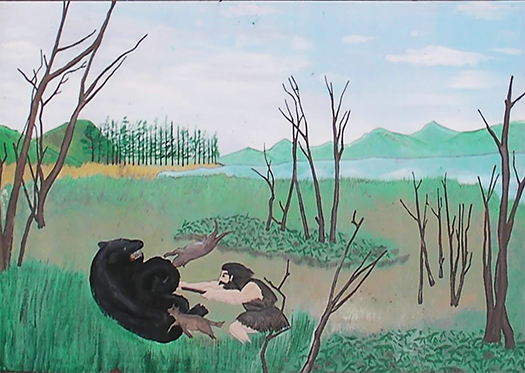


この竪穴の「ところ遺跡」探訪ブログ記事シリーズは、その前の「福島市民家園」で、珍しく復元展示されていた「庶民の住宅」事例で江戸期後期の建築であるのに「土座」住宅に強く惹かれたことがきっかけ。
オイオイ、と深く驚かされたのですね。日本の農耕文化社会でもほんの200-300年前までは、床上げ自体もまだ完全に普及していたとは言えなかったのだという事実。そうだとすれば、わたしたちの住空間意識の基底にまだまだそういった、郷愁のような印象部分が残っているのではないかと想像を膨らませられた。そして竪穴の構造木組みや、外皮の構成、そのデザインマインドのようなものが非常に気になってきたという次第。この「ところ遺跡」はその後のアイヌチセが平地住宅に移行してしまったのに対して、明瞭な竪穴住居としては最後期のものだと考えられた。
米作に適さないと判断されたことで本州以南地域の歴史進行からは「化外」の地とされ続けた北海道ですが、明治以降、旺盛に開発努力が傾注され続けてきた。そのなかで常にテーマ追求されたのは、寒冷気候との格闘史。そのなかで地域の先人であるアイヌ民の住文化、それよりも少し前の人びとの住文化から知見を掘り起こしたいという志向性もあったでしょう。
そういうときに、かれらの生業と本州以南社会の基本生業の違いがあまりにも大きかった。現代は狩猟採集の経済規模とは比較にならないレベルの農耕文化を基盤としている。狩猟採集で養いうる人口規模とはまったく隔絶した人口を涵養しなければならないし、その住環境を構築して行く必要が絶対にある。
そうなんだけれど、こちらの遺跡住宅を見ていると、やはり通底してくるような郷愁的な空間意識を再発見させられる。ひとつひとつの建築素材が醸し出す雰囲気が、なんとも良いいごこちを提供していたように思えてならない。

さて、札幌市の街区でも最近、ヒグマとの遭遇が多く報告されてきている。札幌市からのLINE情報を個人としてわたしは受け取っているが、数日毎に「ヒグマ情報」が発信されてくる。そしてついにわが家周辺の「三角山」付近では一般人の通行を禁止して「山狩り」のようにしてヒグマ除去作戦が展開されてきている。
北海道島の先人のみなさんは、こうした戦いに継続的に立ち向かい、同時に狩猟せざるを得ないヒグマたちへのリスペクトも持ち続けていた。狩猟したヒグマの頭骨は一種の自然神として住居の中の神聖空間に祀っていたといわれる。その叡智に共感を抱いております。
ということで、今回のテーマシリーズ終了とします。
English version⬇
Hunter-Gatherer Culture and Modern Humans – Tokoro-6
A dialogue with the living environment of our ancestors on the island of Hokkaido. Even today, the natural environment and how to maintain a sense of distance from brown bear ecology is a serious theme. How to live, how to live, how to live, and how to live, we continue to learn. The way of life, the way of living, and the way of learning continue to be learned.
This series of blog posts on exploring the “Tokoro Ruins” of the pit was triggered by my strong attraction to the “Doza” houses, even though they were built in the late Edo period, in the unusually restored and displayed “common people’s housing” examples at the previous “Fukushima City Minka-en”.
You were deeply surprised by the “oui oui”. The fact is that even in Japan’s agrarian society, the raising of the floor itself was not yet completely widespread until just 200-300 years ago. If so, it made me imagine that such nostalgic impressions may still remain in the base of our consciousness of living space. The wooden structure of the pit, the composition of the exterior skin, and the design mind of the pit were also of great interest to me. This “Tokoro site” was thought to be the last of the clear pit dwellings, whereas the later Ainu chise had shifted to flatland dwellings.
Hokkaido was regarded as an “exotic” land in the historical progression of Honshu and southward because it was considered unsuitable for rice cultivation, but since the Meiji era, development efforts have been vigorously devoted to the area. The theme that has always been pursued in these efforts is the history of the struggle against the cold climate. In this context, there must have been a desire to uncover knowledge from the housing culture of the Ainu people, who were the predecessors of the region, and of people who lived a little earlier than the Ainu.
At that time, the difference between their subsistence and the basic subsistence of the societies south of Honshu was too great. The present day is based on an agrarian culture at a level that cannot be compared to the economic scale of hunter-gatherer societies. It is absolutely necessary to cultivate a population that is completely different from the size of the population that can be supported by hunter-gatherers, and it is absolutely necessary to build a living environment for that population.
Although this is true, looking at the ruins of these houses, we can rediscover a nostalgic sense of space that seems to run through the whole area. The atmosphere created by the individual building materials seems to have provided a very comfortable atmosphere.
Recently, there have been many reports of encounters with brown bears in the city of Sapporo. As an individual, I receive information on line from the city of Sapporo, and I receive “brown bear information” every few days. Finally, a brown bear removal operation is underway in the area around our house, “Triangle Mountain,” in which the general public is prohibited from passing through the area, as if they were on a “mountain hunt.
Our predecessors on the island of Hokkaido continually confronted these battles, while at the same time maintaining respect for the brown bears that they were forced to hunt. It is said that the skulls of the brown bears they hunted were enshrined in sacred spaces in their dwellings as a kind of nature god. We are sympathetic to this wisdom.
So, this is the end of this theme series.
Posted on 10月 25th, 2024 by 三木 奎吾
Filed under: 日本社会・文化研究







コメントを投稿
「※誹謗中傷や、悪意のある書き込み、営利目的などのコメントを防ぐために、投稿された全てのコメントは一時的に保留されますのでご了承ください。」
You must be logged in to post a comment.